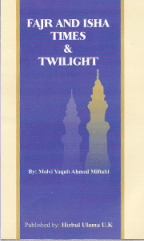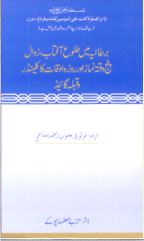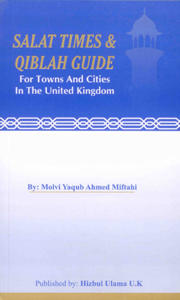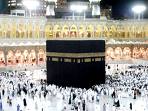Prayer Times
PRAYER SCHEDULE, THAT YOU HAVE, MAY NOT BE CORRECT
Dr. Khalid Saukat's Review about Salat Times. shaukat@moonsighting.comMost Prayer Schedules available on-line lack some important fiqh considerations and result in wrong timings. Moonsighting.com took the initiative to educate the masses about the corrections needed, and provide the "Correct Prayer Schedule" for each prayer as explained below:
Fajr & Isha are calculated by others using different criteria, all over the world. Some use 17°,19°, 20°, or even 21°. Others use 90 minutes, 75 minutes or 60 minutes criteria. These criteria are not valid for all latitudes, as shown by observations for Subh-Sadiq or Disappearance of Shafaq at different latitudes. Research by moonsighting.com shows that any fixed degree is not correct for Subh-Sadiq or disappearance of Shafaq for Isha. This can only be seen if a whole year observation is conducted. Many places in the world [Riyadh (Saudi Arabia), Tando Adam (Pakistan), South Africa, New Zealand, Buffalo (New York), Toronto (Canada)] have done limited observations that are misleading to apply for the entire year. A more comprehensive observation for the entire year was done in Blackburn, Lancashire, England by a group of Ulamaa'. (to download a book published by Hizbul Ulama, 74 Upton Lane London E7 9LW UK).
All collected observations show that for areas at or near equator Shafaq disappearance and Subh-Sadiq occurs in 75 minutes or at 18 degrees in all seasons. As you move to other latitudes, subh-Sadiq and disappearance of Shafaq occurs at different degrees in different seasons. Shafaq disappears at 66 to 100 minutes (9 to 13.6 egrees) at higher latitudes (like England) in different seasons. Subh-Sadiq at higher latitudes is observed at 94 to 122 minutes (14.5 to 10.6 degrees) in different seasons. A decade long research by Moonsighting.com found that the Subh-Sadiq and also the disappearance of Shafaq is a function of latitude and seasons. When this function is checked against all collected observations, it came very close to the observations at all latitudes. Moonsighting.com uses this function of latitude and seasons for calculating Fajr and Isha times.
At latitudes close to or higher than arctic circle, the sun does not set in summer, or does not rise in winter for a number of days. For such situations, a suggestion by Fuqaha', to calculate for nearby lower latitudes where the sun sets and rises, is used.

Caution for Fajr & Isha:
Observations of Subh-Sadiq and disappearance of Shafaq at various locations on earth have confirmed that it is not right to calculate Fajr & Isha, assuming any fixed degree (whether 18° or 15°) or any fixed minutes (like 90 minutes or 75 minutes). Research and observations by Moonsighting.com members have also held this opinion for quite some time. This has also been confirmed by Hizbul Ulama UK, 74 Upton Lane, London E7 9LW, Telephone 0786-646-4040, email: info@hizbululama.org.uk. Read a detailed book, "Fajr and Isha" written by Molvi Yaqub Ahmed Miftahi from UK. This was further confirmed independently by scientists in Pakistan in 2007. Please see an "Urdu letter - Ghaur Talab". Therefore, Moonsighting.com uses a function of latitude and seasons of the year for calculating Fajr and Isha times.
Download Prayer Times for Large Cities in UK ![]()

Zuhr in most Prayer Schedules is shown at Noon (which is before Zawaal). Noon time, when the sun is at its highest point, is Mamnoo' (Prohibited) time for any Prayer. Theoretically, the sun does not go into Zawaal phase until its edges are out of the zenith line (line between the observer to the center of the sun when it is at Noon-phase). It takes about 1.5 minutes for the sun's disk come out of zenith. Additional 1 minute must be added for a 30 miles radius consideration mentioned for Maghrib time. Thus, a minimum of 2.5 minutes must be considered as the minimum limit past Noon time for the beginning of Zuhr. Considering, that this precise theoretical definition is not given by any scholar, a little factor of safety (additional 2.5 minutes) is considered as a minimum for the beginning of Zuhr. Thus, 5 minutes should be added in Noon time for Zuhr.
Asr time calculations require different interpretations by different jurists such as Hanafi, Shafi'i, Maaliki, Hambali, or Ja'friyah (Shi'aa). For Shafi'i, Maaliki, and Hambali, Asr is calculated when the shadow of any object becomes equal to its length. For Hanafi, Asr is calculated when the shadow of any object becomes twice its length. For Ja'friyah, Asr is calculated when the shadow of any object becomes equal 4/7 of its length (as given to me by a follower of Ayatullah Sistani).
Maghrib should be calculated at least as 3 minutes after sunset for the following considerations:
1. The effects of actual humidity, temperature, and pressure in the atmosphere may cause a different refraction of sun light than assumed in calculations.
2. In some areas there could be a downward sloping ground towards western horizon that causes a delayed sunset for an observer compared to a perfectly level ground as assumed in calculations.
3. For major metropolitan cities, the sunset in a 30 mile radius from the point taken in calculation varies. Since the people using this schedule may live all around the city, this may delay sunset for some areas. These are the considerations for the 4 major Sunni school of thought. For Ja'friyah school of thought, 17 minutes after sunset is considered as Maghrib time which is considered enough for the bronze glow on the horizon to disappear.

Qibla direction:
Every day, there comes a time when any vertical object's shadow from the sun is in the Qibla direction. If that does not happen then there is a time when facing the sun gives you Qibla direction. Either of this time is provided for everyday in Qibla column after Isha. This method for Qibla is more accurate than the compass, which involves errors due to the presence of magnetic fields or metallic objects, and magnetic declination which causes compass needle to magnetic North which could be up to 100° off from True North; how many degrees off depends upon the location.



